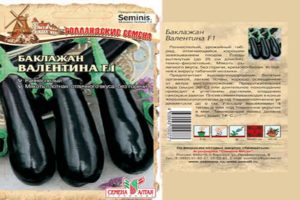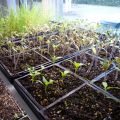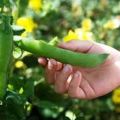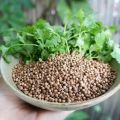Description of the Marzipan F1 eggplant variety, its characteristics and yield
Lovers of large fruits with high taste are increasingly preferring the new Marzipan F1 eggplant variety. The hybrid survives well in hot weather and grows well in the northern regions. To get a rich harvest, we recommend that you study the rules of planting, growing and care in advance. In our article you will find answers to all your questions.
Description of the hybrid
Marzipan F1 is a mid-season hybrid. From the moment of sowing the seeds to the maturity of the fruits, 120-127 days pass. Marzipan is a thermophilic culture. Therefore, it is recommended for growing in the southern regions, where the fruits develop remarkably in the open field. In the central parts of Russia, they are grown in a greenhouse. Eggplants grow large. Despite the strong stem, the bush breaks down due to the weight of the fruit. Therefore, it is imperative to tie up.
Characteristics of eggplant Marzipan F1
Eggplant characteristic:
- the bush grows up to a meter high;
- the pulp is not bitter, pale creamy, sweetish;
- the plant is classified as upright;
- flowers grow in inflorescences, they are also single;
- the sheets are large, green;
- the shape of the fruit is standard;
- average length is about 15 centimeters, width - 8;
- fruits are fleshy and large;
- eggplant contains few small seeds;
- the peel is shiny, purple.

Fruits weighing 300 - 600 grams grow. During the season, about 1.5-2 kg of harvest can be harvested from the bush.
Advantages:
- resistance to adverse conditions;
- high taste, Marzipan is one of the most delicious varieties.
Growing
To get the maximum yield, follow simple guidelines.
Seeds
Seeds must be prepared in advance before planting:
- Warm up for four hours at +25 degrees.
- Soak the seeds at +40 degrees for 40 minutes.
- Disinfect. To do this, you need to place the seeds in a weak solution of potassium permanganate and soak for a quarter of an hour.
- To increase germination, rinse from potassium permanganate and place for 11 hours in any stimulating solution.
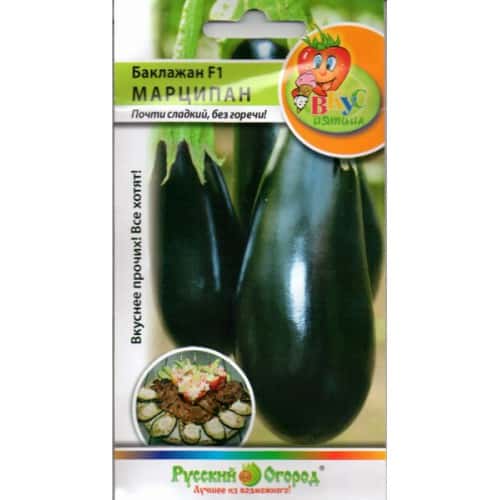
After all stages of preparation, the seeds are placed in a wet cloth and stored in a warm place until germination.
The soil
For growing seeds, use a special universal soil. It is completely prepared for the growth of the vegetable and contains all the necessary components in the correct ratio.
You can prepare the soil yourself. To do this, you can use one of the proposed options:
- Mix 2 parts of humus with part of the sod land.
- Combine humus, peat and sod land in equal proportions.
- Mix humus with earth and coarse sand in equal amounts.
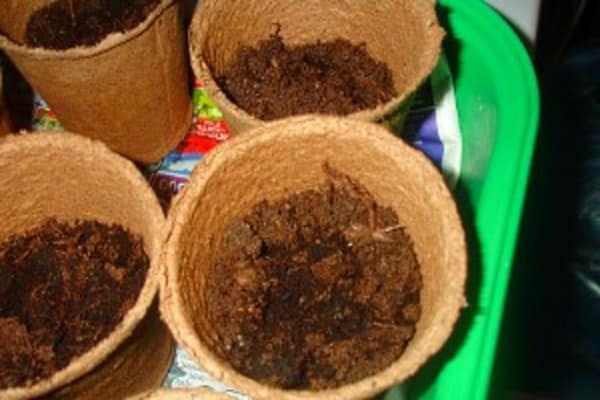
The soil should be slightly acidic or neutral.
Seedling care
Sowing prepared seeds begin in the second half of March. For seedlings use:
- any plastic containers;
- peat pots.
The volume of the container should not exceed 300 ml. There must be drain holes so that excess liquid has a drain. Fill with fertile soil, and then moisturize well.
Seeds are also planted in common boxes at a distance from each other. But later the seedlings will have to dive.
When planting in a cup, the seeds are planted to a depth of no more than one and a half centimeters, one at a time in the center of the container. In the boxes it is necessary to leave a distance of about 5 centimeters between the seeds.

After planting the seeds, you must:
- cover containers with glass or a transparent bag;
- leave the seeds in a warm place with sufficient light. The temperature should be + 22 ... + 26 degrees.
If the temperature regime is observed, the first shoots will appear after 7-10 days. Immediately after this point, you will need:
- monitor daylight hours, which should be 10 hours;
- the temperature at night will be required within + 17 ... + 19 degrees;
- water regularly, but not overmoisten the soil. Do not dry out. Water in the morning and only with settled water. When watering with cold liquid, the likelihood of a black leg increases.
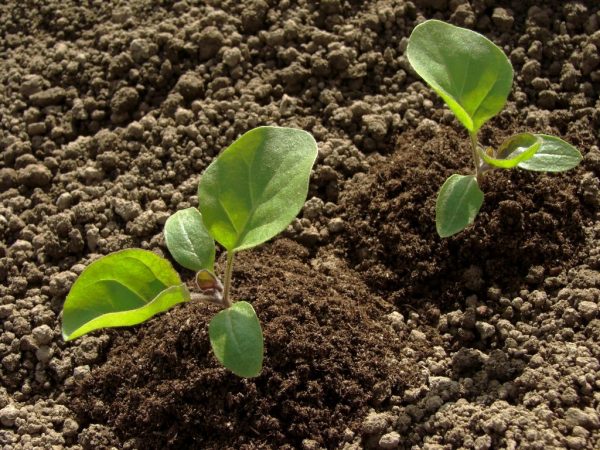
If seeds were planted in a common box, then when a second true leaf appears, they need to be transplanted into separate containers. Before transplanting, water the soil abundantly. This will help you reach the plant without damaging the roots. After transplanting, the root system will begin to form, so growth will slow down.
Landing
It is necessary to plant a plant on the site after the appearance of 8-12 leaves. Eggplants are thermophilic crops, therefore:
- transplanted into the greenhouse in the second half of May;
- in open ground - in mid-June.
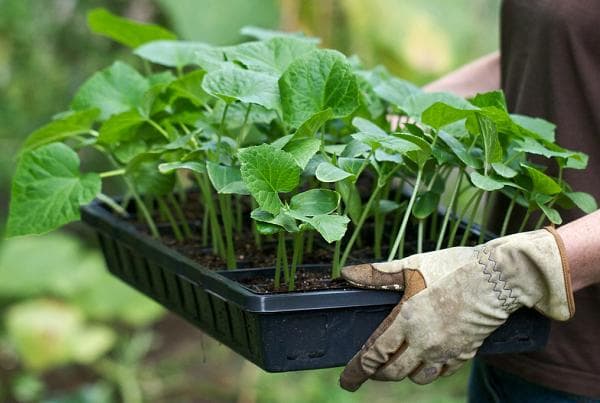
Care rules
To get a good harvest, you will need to properly care for the bushes:
- When the bush reaches a height of 30 centimeters, the stem is tied to a support. In order not to damage the barrel, do not tighten too much. Leave a small margin. Then, a couple of times a month, the resulting lateral shoots are tied up.
- A maximum of 3 strong shoots are left. All the foliage growing below the fork is torn off on the stem. Shoots without fruit formation are cut off.
- Correct leaf removal helps to achieve good lighting of the flowers and reduce the likelihood of gray mold. Be sure to remove secondary shoots.
- During the whole season, damaged and dried foliage is cut off.
- At the end of summer, pinch the top of the stem. Leave 5 ovaries, which can ripen before frost. At the same time, all the flowers are cut off.
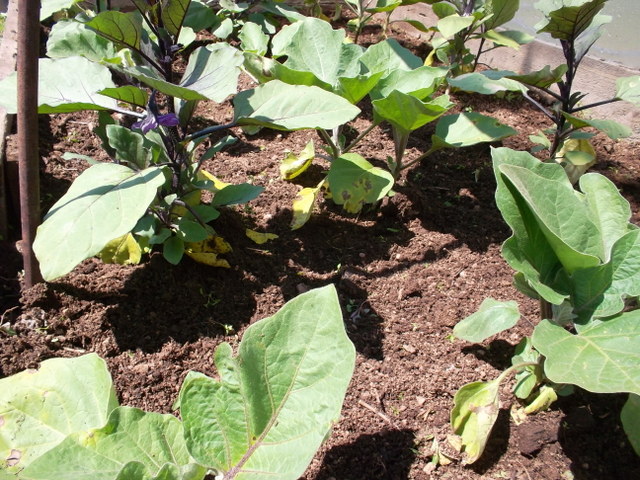
Watering and impregnation
Watering the bush before flowering is necessary once a week. As soon as flowers have formed on the plant, the frequency of irrigation is increased to once every three days.
Only warm water should be used for watering.
Irrigate the soil in the morning or late at night. Watering at the root and loosening the earth. Due to the highly waterlogged soil, the fruits grow small and not very tasty.

The beds are mulched with straw, dried grass or sawdust. This helps to reduce the number of waterings and to retain moisture in the soil. Watering should be reduced in August.
Top dressing
During the entire growth period, fertilizing is carried out several times:
- When the first leaves appear, they are watered with a special mixture. Ammonium nitrate - 5 g, superphosphate - 30 g, sulphate potassium - 10 g are added to a 10-liter bucket.
- 1.5 weeks before planting in the ground in a 10-liter bucket of water, superphosphate is diluted - 65 g, potassium salt - 25 g.
- When the first flowers appear, they are watered with a mixture of fertilizers diluted in a 10-liter bucket. Urea - 5 g, superphosphate - 20 g, potassium sulfate - 5 g.
- At the time of fruiting, a solution is used: water - 10 l, superphosphate - 10 g, potassium salt - 10 g.

Diseases and pests
The most common disease is black leg. The fungus causes darkening of the root neck, from which the bush withers. To avoid disease, before planting the seeds, spill the soil with boiling water and ignite it on a baking sheet for disinfection.
Colorado potato beetles have a great influence on eggplants.
Insects attack after the potato tops dry up. Eggplants ripen on plants by this time. Therefore, chemical treatment cannot be carried out. A fine mesh up to a meter high will help to avoid insect attacks.

Harvesting and storage
Under suitable conditions, the fruit retains its appearance and taste for several months. Eggplants reach technical ripeness in 1-1.5 months after flowering. The fruits are colored deep purple. The pulp becomes firm and the seeds turn white.
The fruits ripen gradually, so they are collected selectively, checking the degree of ripeness every three days. Cut with a pruner or a well-sharpened knife, leaving 3 centimeters of the stalk.
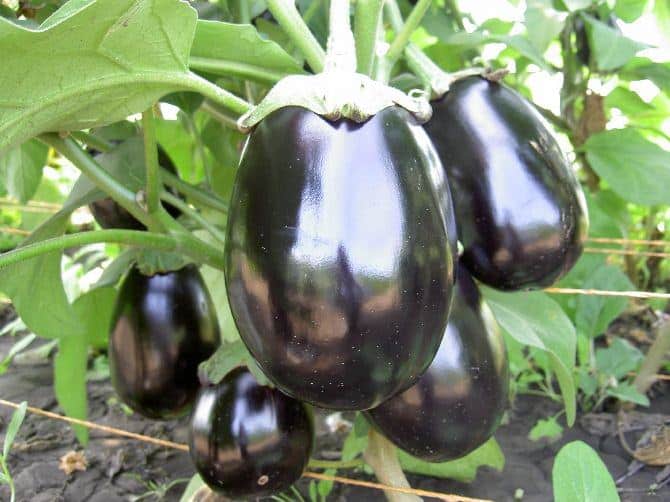
For storage, the eggplant is wiped with a dry towel and placed in the basement. Room temperature from 0 to +2 degrees. They are stored on the floor for two weeks, placing them in a maximum of two layers. After three weeks, the intact, firm fruit is taken and wrapped in paper. Then they are laid out on straw and covered with a thick cloth. If all conditions are met, you can enjoy the taste of fresh eggplant for 3 months.

